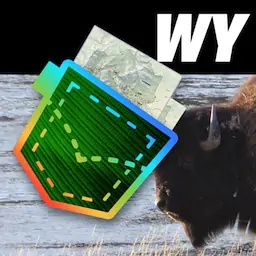"Grand Teton, Moose Entrance" by U.S. National Park Service , public domain
Bird Finding GuideNature |
Bird Finding Guide for Grand Teton National Park (NP) in Wyoming. Published by the National Park Service (NPS).
featured in
| National Parks Pocket Maps |  | |
| Idaho Pocket Maps |  | |
| Wyoming Pocket Maps |  | |
| Yellowstone Pocket Maps |  |
Grand Teton
National Park Service
U.S. Department of the Interior
Grand Teton National Park
John D. Rockefeller, Jr.
Memorial Parkway
Bird Finding Guide
The mountains, rivers and lakes of Grand Teton National Park provide a picturesque backdrop for
bird watching. Over 330 species of birds live in the various park communities including alpine, forests,
meadows, sagebrush flats and riparian. Use this guide to learn about the communities found here, places
to look for birds and some of the inhabitants. Pick up a park map and bird checklist at a visitor center to
assist your search. Please report any sightings of birds listed as rare or accidental on the checklist. With a
keen eye, you can discover some of the birds that grace this landscape.
Communities
Birds inhabit a variety of communities throughout
the park and parkway. They are searching for
food, water, shelter and nesting sites. Some birds
frequent only one community while others occupy
a variety.
Alpine
Elevation, harsh winters and brief summers limit
vegetation to low-growing forms. Birds that nest
above treeline migrate south or to lower elevations
for winter. Watch for golden eagles, ravens,
Clark’s nutcrackers, rosy finches, white-crowned
sparrows and water pipits.
Lodgepole Pine Forests
Dense lodgepole pine forests cover glacial
moraines on the valley floor and the lower
mountain slopes. Look for olive-sided flycatchers,
yellow-rumped warblers, ruby-crowned kinglets,
mountain chickadees, white-crowned and
chipping sparrows and dark-eyed juncos.
Aspen Forests
Aspens often occur in pure stands on hillsides.
Trees with rotting trunks attract woodpeckers.
Bird Notes
Just a note about a few interesting species adapted
to thrive here.
• Greater Sage Grouse: In early spring, sage
grouse gather for courtship in areas called
“leks.” Males display for females at dawn. This
species is in decline due to habitat loss.
• Trumpeter Swans: The largest waterfowl in
North America is making a comeback after near
extinction in the early 1900s. Look for these
birds in ponds and rivers.
• Barrow’s Goldeneye: A cavity-nesting duck
that lives here year-round in rivers and lakes.
• Great Gray Owl: The tallest owl in North
America with the largest wingspan. Males
hunt during daylight making them visible in the
lodgepole forest.
• Bald Eagle and Osprey: Fish loving raptors
thrive along the Snake and Gros Ventre rivers
and the valley lakes.
Later, abandoned woodpecker cavities provide
nesting opportunities for saw-whet owls, house
wrens, mountain and black-capped chickadees,
tree swallows and violet-green swallows.
Sagebrush Flats
Sagebrush thrives in rocky, well-drained soils
in a semi-arid environment covering much of
the valley floor. Despite these harsh conditions
many species flourish. Look for sage grouse,
vesper sparrows, western meadowlark, mountain
bluebird, Brewer’s sparrows and sage thrashers.
Aquatic and Riparian
Numerous rivers, creeks, lakes and ponds provide
habitats where Canada geese and other waterfowl
nest, while osprey and bald eagles hunt for fish.
Common snipe, white-crowned and Lincoln
sparrows, yellow and MacGillivray’s warblers,
and common yellowthroats nest in adjacent wet
meadows. American dippers search for insects in
fast-moving mountain streams. Look for common
mergansers, Barrow’s goldeneyes and mallards
in small ponds and rivers and American white
pelicans on Jackson Lake and the Snake River.
• American Dipper: A small aquatic songbird
that frequents cascading streams. Known for
its up and down bobbing motion as it forages
for aquatic insects.
• Clark’s Nutcracker: Both males and females
tend a high-elevation nest. They gather large
conifer seeds from whitebark and limber pines
and cache them for later.
• Red Crossbills and Pine Grosbeaks: Large
red finches that inhabit mature, open pine
forests. The crossbill beak prys apart pinecone
scales for the bird to gather the seeds.
• Western Tanager: These colorful birds winter
in southern Central America and nests in the
lodgepole forests. The redder the male’s
feathers, the more fit he is.
• Calliope Hummingbird: The smallest bird
north of Mexico feeds on nectar from tubular
wildflowers.
Birding Hot Spots
Grand View Point
Old growth Douglas firs support Williamson’s
and red-naped sapsuckers. Songbirds include
mountain chickadees, red-breasted nuthatches,
western tanagers, Townsend’s solitaires, and darkeyed juncos. Dusky and ruffed grouse nest here.
Christian Pond
Look for waterfowl such as ruddy ducks, ringnecked ducks, American wigeon, American coots,
and the occasional Trumpeter swan.
Willow Flats
Extensive willow thickets merge with wet grassy
meadows crossed by small creeks and beaver
dams. Cinnamon teal, green-winged teal and
American wigeon frequent ponds and creeks.
Sandhill cranes, northern harriers, American
bitterns, common snipes and soras nest here.
Calliope hummingbirds feed on scarlet gilia. Red
naped sapsuckers and other woodpeckers abound.
Frequent songbirds include willow flycatchers;
cliff swallows; yellow, MacGillivray’s and Wilson’s
warblers; common yellowthroats; fox and whitecrowned sparrows; pine siskins; and yellowheaded blackbirds. Lazuli buntings and greentailed towhees use the drier hillsides adjacent to
Willow Flats.
Oxbow Bend
A meander of the Snake River, Oxbow Bend
provides lush underwater plant growth and
abundant fish for aquatic birds. Look for great
blue herons, osprey, American white pelicans,
double-crested cormorants, common mergansers
and bald eagles.
Two Ocean Lake
Western grebes, trumpeter swans, common
mergansers and common loons summer on the
lake. Western tanagers, pine grosbeaks, Cassin’s
finches abound in the open forests nearby.
North Jenny Lake Trail
In 1999 a lightning-caused wildland fire burned
the area north and west of Jenny Lake. Insects
feeding on decaying trees attract black-backed
and three-toed woodpeckers. Insects also attract
mountain bluebirds, tree swallows, olive-sided
and dusky flycatchers, western wood-pewees and
yellow-rumped warblers.
Bird Watching Etiquette
Birding is a popular activity. In national parks,
you have the opportunity to observe birds in
their natural environment. Enjoy birds but be a
responsible birder.
Cascade Canyon
Cascade Creek carries snow melt through forests
and meadows of wildflowers. American dippers
bob in the creek and secretive harlequin ducks
sometimes nest nearby. Western tanagers, rubycrowned kinglets and yellow-rumped warblers
nest near the trail. Look for golden eagles, Steller’s
jays, gray jays, golden-crowned kinglets, dark-eyed
juncos and occasional Townsend’s warblers.
Antelope Flats – Kelly Road
Large hayfields attract raptors such as American
kestrels, prairie falcons, red-tailed and
Swainson’s hawks and northern harriers hunting
small rodents. Check fence posts for western
meadowlarks, western and eastern kingbirds and
mountain bluebirds. Scan the old pastures for
long-billed curlews and savannah sparrows.
Menors Ferry at Moose
Follow the pathway to homesteader cabins along
the Snake River. Violet-green, tree, cliff and barn
swallows scoop insects out of the air as western
wood-pewees, dusky flycatchers and mountain
bluebirds hawk for flying insects. Yellow warblers
glean insects from cottonwood trees and shrubs.
Calliope, broad-tailed and rufous hummingbirds
seek wildflower nectar. Kingfishers, common
mergansers, ospreys and bald eagles catch fish.
Laurance S. Rockefeller Preserve
Several trails follow creeks and traverse a glacial
moraine with mixed conifers and aspens. Look
for western tanagers, MacGillivray’s warblers,
northern flickers, Lazuli buntings, ruby-crowned
kinglets and green-tailed towhees. Listen for the
sweet songs of hermit and Swainson’s thrushes.
Calliope and broad-tailed hummingbirds feed on
scarlet gilia.
Blacktail Ponds Overlook
From this overlook north of Moose Junction view
many different communities. Wetlands are home
to American wigeons, blue-winged teal, mallards,
and goldeneyes. Up to six species of swallows
zip by catching insects. Bald eagles and osprey
roost in the cottonwoods. Yellow warblers, song
sparrows and willow flycatchers frequent the
willows.
• Nesting birds are easily disturbed. If an
BEARadult on a nest flies off at your approach or
you and screams an alarm, you are too
AWAREcircles
close. Unattended nestlings quickly succumb to
BEAR
AWARE
FOOD
STORAGE
REQUIRED
E X P E R I E N C E Y O U R A M E R I C A™
predation or exposure to the elements.
• Do not feed birds or any wildlife.
• Do not play bird songs or use bird calls. Such
sounds disturb territorial males and nesting
pairs.
• Stay on trails to preserve delicate habitat.
• Obey all wildlife closures.
• Good birding areas often attract other wildlife.
Maintain a distance of at least 100 yards from
wolves and bears and 25 yards from other
animals. Do not position yourself between a
female andFOOD
her offspring.
KEEP
FOOD
STORED
STORAGE
REQUIRED
rev. 2017




